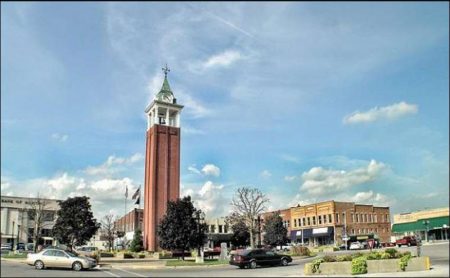Cairo (315 alt., 3,632 pop.), southernmost city of Illinois and seat of Alexander County, stands on the tip of a narrow peninsula where the Ohio pours its gray waters into the yellow Mississippi. Somewhat exotic for Illinois are Cairo’s ginkgo and magnolia trees, its nearby canebrakes and cottonfields. Many Illinoisans and others blink on learning that the city is farther south than Richmond, Virginia, or Tunis, Africa.
Cairo is encircled by a huge levee that rises from the river delta like the ramparts of a walled town. Steamboats have whistled for a landing on the Ohio side since the 1840’s. But most of the whistles have been stilled by the railroad, and today the levee, its revetted slope scoured clean by the river, has no more than a half-dozen sternwheelers moored along its mile-length.
The street fronting the levee is lined with hotels, shops, and taverns, many of them deserted and falling to ruin, their weathered façades embellished with bracketed cornices, rows of dentils, and balconies of wrought iron. Of this quiet street, in which grass now sprouts between its pavement bricks, the Cairo Gazette reported in 1863: “Every house, cellar, and shed is occupied as a place of business and every occupant is doing well.”
The population of Cairo has declined from a 1920 high of 15,203 to 3,632 in 2000. Cairo today faces many significant socio-economic challenges, including poverty, education, and employment.
The first attempt at settlement here occurred in 1818 when John G. Comegys, a St. Louis merchant, obtained from the Territorial Legislature an act incorporating the city and the bank of Cairo. The projected city was so named because its site was presumed to resemble that of Cairo, Egypt. When Comegys died about 1820, his scheme perished with him, but he had made a lasting contribution to Illinoisana in his choice of the name Cairo, for as a result “Egypt” has become the popular name of southern Illinois.
A second and successful attempt at settlement began in 1837 when the State legislature incorporated the Cairo City and Canal Company, with Darius B. Holbrook, “a shrewd Boston Yankee,” as president. Holbrook hired several hundred workmen to build a levee, shops, and houses. The settlement was widely advertised in England, where the bonds of the Cairo City and Canal Company found eager purchasers through the London firm of John Wright & Company.
This latter concern failed on November 23, 1840, and Cairo immediately declined, its population dropping from a thousand to less than a hundred within two years. Those who remained conducted shops and taverns for steamboat travelers. Charles Dickens visited Cairo on April 9, 1842; several historians have suggested that his interest in the settlement was inspired by his unprofitable investments in Cairo City bonds, but this is not established. In any case, he damned Cairo vigorously in American Notes ( 1842), using it as the prototype of the nightmare City of Eden in Martin Chuzzlewit (1843).
The discredited Cairo City and Canal Company was reorganized as the Cairo City Property Trust in 1846. Plans were laid to make Cairo the main depot of a trade route running south to the Gulf by water and north to the Great Lakes by rail. This necessitated the construction of a railway through Illinois, the cost of which was to be defrayed by a Federal land grant. In response to pressure generated by the Cairo City Property Trust, Congress gave Illinois more than 2,000,000 acres of public land in September 1850. The Illinois Central Railroad Company, beneficiary of the grant, was incorporated in 1851, and four years later a track between Cairo and Chicago was opened to traffic.
Cairo took root at once and prospered; its population had increased to 1,756 by 1857, the year in which a city charter was obtained. Each succeeding month increased the volume of products transported along the north-south route. This route might have become part of the basic economic pattern of the Middle West, with Cairo as a commercial capital, had not the Civil War dammed up the developing trade route. When gunboats drove the packets from the lower Mississippi, the corn and pork of central Illinois began to move in increasing amounts to Chicago, as they have continued to do, and Cairo ultimately ceased to be of importance as a regional commercial center.
Throughout the war Cairo was a concentration point of the Union Army and the base of the Western Flotilla, later renamed the Mississippi Squadron. One week after the fall of Fort Sumter, Cairo was garrisoned by 2,000 Illinois volunteers to prevent its seizure by Confederate troops, who had advanced within twenty miles of the city. The point at the junction of the rivers was fortified as Camp Defiance. Anthony Trollope, the English author, who visited Cairo in the winter of 1862, later reported in North America that the “sheds of soldiers” at Camp Defiance were “bad, comfortless, damp, and cold,” but that they did not “stink like those of Benton barracks at St. Louis.”
Ulysses S. Grant, then commander of the district of southeastern Missouri, established his headquarters at Cairo in September 1861. Here he massed men and gunboats for an arrow-like offensive that began early in February 1862, and resulted in the capture of Fort Henry, February 6, and Fort Donelson, February 16. Fourteen thousand Confederates were transported to Cairo to await confinement in Northern prisons. Later, when Vicksburg fell, some 30,000 Confederates were brought here.
By the end of the war Cairo had an estimated population of 8,000. In 1867 more than 3,700 steamboats docked at the city, a figure that made predictions about the decline of the steamboat seem absurd. Later, when the supremacy of the railroad was established, Cairo offset the loss in part by developing local plants to process cottonseed oil and mill lumber. In the last quarter of the century seven railroads were built into the city. Mark Twain, most notable of the steamboatmen who had gone “booming down to Cairo,” observed in Life on the Mississippi ( 1883) that “Cairo is a brisk town now and is substantially built and has a city look about it…”
Views: 184



